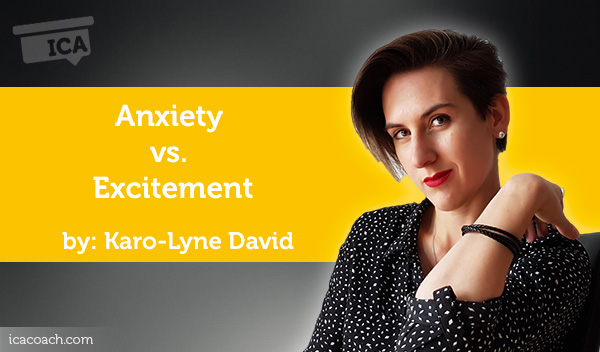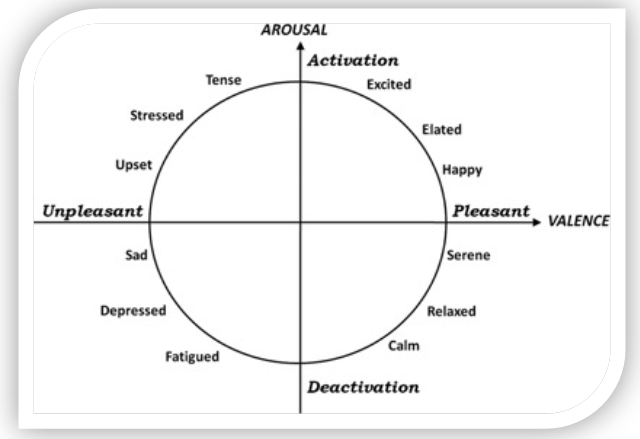
A Coaching Power Tool Created by Karo-Lyne David
(Anxiety Coach, CANADA)
Introduction
When thinking about future events, anxiety serves an adaptive function; it allows us to prevent or avoid dangerous situations. If we assess that a challenge surpasses our current skills or resources, we will most likely experience some anxiety.
In my experience, anxiety can also become one of the biggest obstacles to taking action and achieving results. Being too focused on preventing/avoiding “dangerous situations” can keep us from making necessary changes.
Not so long ago, whenever I thought about doing something, I would plan for all the things that could go wrong. Most of the time, I was paralysed by the thought of failure or making a mistake. In fact, until recently, anxiety was still holding me back; I was stuck in a disempowering thought pattern and self-justifying behaviors.
Taking responsibility for my happiness was a very significant shift that led me to make different choices and redesign my life. But in my opinion, things really started changing when I started taking action despite my anxiety. At the time, it felt like a leap of faith. I made a move simply because the pain of staying put exceeded the fear of taking a risk.
Now, more than a year and a half later, I can say that this emotional roller coaster is behind me. I’ve now made it my mission to share my experience in order to help people who struggle with their emotions, and especially with anxiety. My hope is that through my coaching, I will be able to support people in creating this shift for themselves with less time and suffering.
Anxiety vs Excitement is one of the tools that I’ve discovered. Its objective is to reframe a person’s anxiety and allow them to move forward in spite of it. This cognitive reappraisal strategy is mostly based on the circumplex model of affect and Alison Wood Brooks’ research in the field of experimental psychology.Both of these will be covered in the following sections.
Framework
What is the circumplex model of affect?
This model is one of many we can use to categorize different emotions in relation to one another. In this particular model, emotions are distributed in a two-dimensional circular space and classified according to arousal and valence.
 The vertical axis represents arousal or activation; it’s the amount of energy associated with a feeling.
The vertical axis represents arousal or activation; it’s the amount of energy associated with a feeling.
The horizontal axis represents valence or positivity;it’s the amount of pleasure associated with a feeling.
For instance, the feeling of sadness is a state of low arousal and negative valence, whereas the feeling of happiness is a state of high arousal and positive valence.
What is a cognitive reappraisal strategy?
In psychology, the appraisal theory suggests that one’s interpretation of a situation determines that person’s emotional experience. In other words, the affective response of an individual to a specific event would depend on his/her appraisal of said event.
Example:
Two professors react after their colleague is promoted; one feels happy for her friend, while the other feels resentful because he thinks he is more deserving of the promotion.
Depending of the person’s assessment of a situation and the meaning that person associates with the event, the emotional response can be very different.
So cognitive reappraisal is simply an emotional regulation strategy that involves changing one’s perception and interpretation of an event. By giving the story a different meaning, the person is altering the emotional response to the stimulus. This is especially helpful in stressful situations that are out of the person’s control.
Research
While googling the topic of anxiety, I came upon an interesting article titled “Get Excited: Reappraising Pre-Performance Anxiety as Excitement”. While most people would usually suggest to calm down when anticipating a stressful event, the author investigated a different strategy: reappraising anxiety as excitement.
The study evaluated people’s performance in three minor stress-inducing situations:
Results
The participants’physiological response to stress remained the same in every group: there was no significant effect of reappraisal on the heart rate which remained elevated during the event.
The participants’ emotional response changed: people who reappraised their anxiety as excitement reported feeling more excited.
The participants’overall performance improved significantly in the test group (excitement reappraisal) compared to the other groups (calmness reappraisal or neutral) in every event.
Interpretation
The author indicated that when individuals reappraised anxiety as excitement, it led them to feel more excited and to adopt an opportunity mindset (as opposed to a threat mindset), which then improved their subsequent performance.
She also pointed out that these findings suggest the importance of arousal congruency during the emotional reappraisal process. This means that it might be easier to reappraise a feeling if we preserve the arousal state while changing its valence.
Coaching Application
Sometimes, when a situation in out of the client’s control and causes anxiety, it can be helpful to simply reframe the situation from an excitement perspective.
In my experience, when the anxious spiral gets out of hand, everything becomes a threat and everything is too much too handle. I like to call it “survival mode”.
One way to get the client out of their head is to have them focus on their bodily sensations. Maybe the client is experiencing heart palpitations, sweating, trembling, shortness of breath, or any other symptom commonly associated with anxiety. While they’re focusing on that, it can be interesting to point out to them that the same symptoms are also associated with excitement.
Examples:
- What if this anxiety was actually excitement?
- What if instead of being afraid of the unknown,
- you were excited to discover something new?
- What would that be like, look like, feel like?
It’s interesting to note that even minimal strategies of reappraisal can be effective, as demonstrated in the research. As a coach, we can guide our clients to their own knowledge and help them develop their own reappraisal strategies, such as self-talk or self-affirmations
(ex: say “I am excited” out loud).
Examples:
- How can you apply this technique the next time you feel anxious?
- What else could you do to transform your anxiety into excitement?
Conclusion
Overall, anxiety vs excitement can be used to shift a client’s perspective between one of negative anticipation to one of positive anticipation. The shift is made easier by the arousal congruency of the reappraisal process.
As coaches, we can use this technique to facilitate the cognitive regulation of emotion in a client struggling with anxiety. This can then help them get out of a threat mindset and into an opportunity mindset which will then support them in taking action.
[1] WOOD BROOKS, Alison. “Get Excited: Reappraising Pre-Performance Anxiety as Excitement”. Journal of Experimental Psychology: General, Vol.143, No.3, [online] www.apa.org/pubs/journals/releases/xge-a0035325.pdf (consulted on March 25th, 2018)